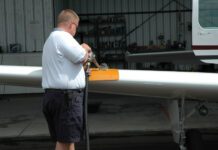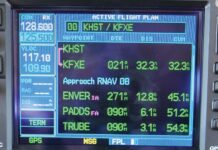The FAAs Wide Area Augmentation System (WAAS) has been widely hyped as a boon to safety because it offers more precise approach guidance with vertical capability. While thats true on some approaches, it can also cost an aircraft owner a bundle of money. Worse, the market offers limited choices in equipment-Garmins GNS430/530W and G1000 are among the short list. 288 There are plenty of reasons to buy WAAS, and for many new installations WAAS comes standard. Theres also ADS-B, which relies on a WAAS-enhanced GPS position. But is the safety enhancement worth the upgrade costs for the typical pilot? And what exactly are you getting out of the WAAS deal? WAAS for dummies What were once generalized as GPS approaches are now classified as RNAV (area navigation) approaches with familiar LNAV lateral guidance. Moreover, many non-precision LNAV approaches offer “artificial” vertical guidance, called LNAV+V. This GPS-derived glidepath looks and flies like an ILS displayed on a traditional navigational indicator or EHSI. The LNAV approach with available vertical guidance is considered non-precision and is subject to downgrade based on signal integrity. In other words, if the signal becomes unstable, the glideslope goes away and youll either discontinue the approach or fly the published step-down procedure. The more precise LPV-localizer performance with vertical guidance-is the GPS equivalent of an ILS approach. Further, many traditional ILS approaches also have an RNAV approach overlay on the same runway-often but not always with similar minimums (see the sidebar on the opposite page for a couple of comparisons). The FAAs intention when implementing WAAS approach technology was to create LPVs with minimums as low as 200 feet-a rarity to date. Of course, actual minimums are governed by available terrain clearance and other factors related to the airport environment, but 250 feet is not unheard of. Confusing to some are the LP approaches. This is a non-precision GPS approach with lateral guidance equivalent to the localizer on an ILS approach. For airports with terrain obstructions prohibiting LPV operations, the LP approach simply offers the lowest possible MDA given the environment. If youve flown even a handful of RNAV approaches, youll recall the signal quality and cockpit indications are far more stable than a traditional ILS approach, where scalloping needles can cause performance flaws for an approach-coupled autopilot (not to mention the challenges they cause the hand-flying pilot). This stability is proving to be a sizeable benefit for upgrading to WAAS. Since most autopilots simply grab the left/right action from the navigation displays CDI or meter movement, the resultant scalloping and unstable needles can cause grief for even the tightest of autopilots. For autopilots and connected control cables that are out of tune in the first place, the anomaly can be magnified significantly. As for flying with WAAS, the benefits are convincing, at least on paper. It provides better than 1.5-meter horizontal accuracy and three-meter vertical accuracy. Class 3 WAAS capability allows for legal sole means of navigation with no other navigational gear required. If this sounds like putting all your eggs in a single basket, it is, and owners rely heavily on quality installations and even higher equipment standards. And this is where the upgrade gets pricey to a questionable level. Hard numbers If you arent equipped with an IFR GPS, the easy way to resolve that is to buy a new $11,295 Garmin GNS430W or big-screen $16,495 530W-these give you the WAAS standard in one shot. The boxes dont include required navigational indicators, which could add another $2000 if you dont have an appropriate model (most HSIs will work). Any of the GNS units lacking have the “W” suffix are the discontinued legacy boxes. These earlier machines have no WAAS-enabled receiver or the processor to support it, but they can be upgraded, for a price. For this reason youll need to be careful shopping the used avionics market. If you have a legacy unit, Garmin charges $3000 for the WAAS upgrade and your shop will need to swap the GPS antenna and its signal connector, plus the effort to rewrite your Flight Manual Supplement and conduct post-installation flight testing. Upgrade efforts and pricing are all over the board-basic single-engine models with easily accessed GPS antennas can be upgraded to WAAS for around $1000 in labor, plus the box. Fly a pressurized twin or big single with a fancy one-piece interior and that number can triple. But real sticker shock is when the shop opens up the interior and finds old, non-shielded coaxial cable between the antenna and navigator. The WAAS interface calls for twin-shield and low-loss cable to ensure signal integrity. Given the teardown to route new cable through the airframe, this effort can be huge and come with a correspondingly high price tag. For aircraft where the navigator is displaced a certain distance from the navigational indicator, the AML-STC requires redundant GPS mode annunciation. The FAA, when approving the STC, wants to be sure pilots can easily see the numerous cues and mode warnings that are present during approach ops. If the navigator and course indicator are mounted too far to the side, youll need mode annunciation. This is true of many Beech Baron and Bonanza models, where the radio stack is offset to the right side of the panel. Early steam-gauge Cirrus models fall into this category, too, with radio stacks down low in the center panel. Such redundant controls and annunciator accessories could add $1000 or more to a basic installation. Its easy to see how a $5000 bill to upgrade existing GNS units isnt rare. But five grand seems trivial compared to upgrading some glass-cockpit models. A look at WAAS upgrade pricing for these aircraft is staggering. Cessnas Service Bulletin SB07-34-07 lists the GPS/WAAS upgrade kit at $18,295 for single-engine G1000 models: Manpower is listed at approximately 11.5 hours. Meanwhile, Garmin and Hawker Beechcraft also offer an upgrade path for non-WAAS G1000 G58 Baron and G36 Bonanza aircraft. Each GIA63W LRU for the suite is $11,495 and Garmin offers a $1750 credit for the legacy GIA63. Theres also the GDU1045 MFD thats exchanged for $11,595, minus $1000 credit for the old MFD. While these numbers are tough to swallow, having an otherwise state-of-the-art glass aircraft without WAAS GPS seems silly to most owners. Wed have to agree. We also agree that trying to sell a G1000 aircraft without WAAS will be a challenge. Forget the suspenders Compared to early generation units, the new WAAS GPS engines, processors and software are reliable and highly accurate. Nearly gone is the potential issue of not having RAIM-receiver autonomous integrity monitoring-which helps monitors signal quality and alerts the pilot to reception anomalies. But WAAS not only enhances GPS accuracy, it also increases the equipments ability to monitor signal integrity, and then takes it to a higher level. Garmin has FDE (fault detection and exclusion) built into its 400W- and 500W-series navigators. The fault detection detects satellite failure while exclusion simply ignores one or more failed satellites ultimately affecting the signal integrity and performance of the unit. Further, the GNS400W and 500W units offer on-board RAIM prediction computations that allow the pilot to predict the RAIM availability at a specified waypoint on a specified arrival date and time. This helps determine if satellite coverage is adequate for the flight. What this means is there should be no surprises caused by sliding down a precision GPS approach when the navigator gives up the ghost because of a signal problem. Moreover, the boxes are smart enough to “downgrade” a precision GPS approach back to an old-fashioned non-precision GPS approach (by eliminating vertical guidance, for example). On the flip side, weve found WAAS GPS receivers can be overly sensitive or naturally susceptible to stray RF noise that might be present in and around the airframe. Strobe noise, com radio interference and pulse noise are a few enemies. For these reasons, a WAAS receiver can be an ongoing source of hassles in some aircraft. Conclusion In the end it all rides on a big money question owners continue to wrestle with: Will the extra money and effort spent on WAAS increase the mission profile? For the IFR pilot who approaches airports without an ILS-or even airports served by an ILS-we think WAAS offers some benefits. But it isnt that easy: Investing in non-precision GPS gear and installation doesnt make a whole lot of sense. Most owners bite the bullet and spring for a GNS430W and the WAAS capability that tags along. Even if they rarely find themselves on a LPV approach, having WAAS capability could prove useful someday as ADS-B threatens by each passing month. Clearly, WAAS technology is here to stay. Larry Anglisano is the Avionics Editor at sister publication 



